As someone deeply fascinated by historical fashion, particularly the elegance of Victorian gowns, I often find myself drawn to the styles of bygone eras. Being an Arizona native with roots as a Daughter of Utah Pioneers, now residing in Denver, my interest has naturally extended to the clothing of the Western frontier. This intersection of interests sparked a curiosity about how pioneer clothing, specifically the Pioneer Dress, differed from the fashions prevalent in established Eastern cities during the 19th century.
Pioneer women faced unique considerations when it came to their wardrobes. Beyond mere aesthetics, practicality, social class nuances, and available resources played crucial roles in shaping their clothing choices. In this article, we’ll delve into the fundamentals of pioneer women’s attire, focusing on the iconic pioneer dress, and explore how these garments reflected the realities of frontier life.
Defining the Frontier Context
For the scope of this discussion, “frontier” refers to the regions west of Missouri and Arkansas, primarily during the period from approximately 1850 to 1890. The pioneer dress and broader wardrobe styles discussed here are representative of women homesteaders and those living in settlement communities, largely focusing on white settlers migrating westward from the East.
What’s captivating about pioneer clothing is that it transcended mere social status or purchasing power. It spoke to a shared experience, a common bond among families pursuing dreams and venturing into the uncharted territories of the American West. The pioneer dress, in its simplicity and functionality, embodies this spirit of resilience and adaptation.
Layers Beneath: Pioneer Undergarments
Interestingly, the foundation garments worn by women on the frontier weren’t drastically different from those in Eastern cities. The chemise remained a fundamental undergarment – a light cotton slip worn next to the skin, primarily for hygiene and frequent washing. Pantalets, made of flannel or cotton, were also common, serving purposes of modesty, as dedicated underpants were not yet widely adopted.
Contrary to initial assumptions about simplified frontier attire, corsets were a staple for most pioneer women, worn over the chemise and pantalets. Many women journeying west were driven by aspirations for a better future, whether for economic or religious reasons. They were “proper” and proud women who generally upheld societal norms, and the corset was considered an essential element of respectability during that era.
While women engaged in strenuous labor might loosen or temporarily forgo their corsets for comfort while performing household chores, the majority of frontier women brought corsets with them and wore them as often as circumstances permitted.
Following the corset came petticoats, offering layers and volume to skirts. Pioneer women often possessed multiple petticoats, choosing among them based on the formality of the occasion or the prevailing weather conditions. Stockings were considered essential when leaving the house or receiving guests, typically held up by garters or tucked into pantalets – a method that indeed sounds rather uncomfortable by modern standards.
Fabrics of the Frontier Dress
Calico emerged as the quintessential fabric for pioneer clothing, including the daily pioneer dress. While often associated with quaint floral prints, calico is fundamentally a type of plain-woven cotton fabric, slightly coarser than modern canvas. Its lightweight yet sturdy nature and ease of cleaning made it ideal for the demands of outdoor life on the frontier. Calico was available in various dyed colors at general stores, or women could dye it themselves using commercially available dyes or natural pigments derived from plants like leaves, bark, berries, and fruits.
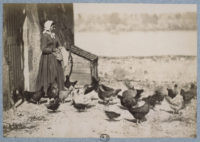 Pioneer woman in a calico dress and apron standing outside a log cabin.
Pioneer woman in a calico dress and apron standing outside a log cabin.
Cotton and silk fabrics were still reserved for “Sunday best” attire and more formal dresses. Many women brought finer garments made from these materials with them as they moved westward. Fabric availability depended heavily on access to general stores, which varied greatly across the frontier. In more isolated areas, families often resorted to homespun fabrics, a craft deserving of its own dedicated exploration.
Daily Wear: The Practical Pioneer Dress
Regardless of their backgrounds in the East, women in frontier settlements were integral to establishing and maintaining homes and farms. Their days were filled with essential tasks: cooking, cleaning, childcare, laundry, and often, field work. The family’s success hinged on everyone’s physical contributions, and domestic tasks were rarely outsourced. Frontier women quickly adapted to a life of manual labor.
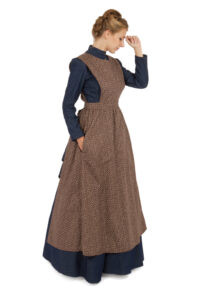 Close up of a pioneer calico apron with ties.
Close up of a pioneer calico apron with ties.
Pioneer Calico Apron
The general dress styles of the era – fitted bodices and full skirts – were adopted for the pioneer dress, but with practical modifications for frontier living. Daily wear dresses featured skirts hemmed approximately three inches shorter than fashionable city dresses, improving mobility for work. Weights were sometimes sewn into the hems to prevent skirts from blowing up in windy conditions, ensuring modesty.
Bodices remained fitted, but sleeves were loosened and extended to the wrists, often paired with high collars to shield against the sun’s harsh rays. Laundering pioneer clothing was a significant undertaking. The concept of “wash dresses” emerged, described in Chris Enss’s book How the West Was Worn. These were often two-piece dresses of white cotton with printed patterns, valued for their easy care and sold in stores or made by seamstresses. “Wash dresses” became popular across socioeconomic lines, demonstrating fashion’s adaptability to the practical needs of frontier life.
Sunday Best: Pioneer Dresses for Church and Community
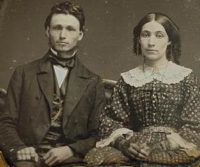 A pioneer couple dressed in their Sunday best standing outside their home.
A pioneer couple dressed in their Sunday best standing outside their home.
While frontier families often lived in relative isolation, settlements with multiple families typically established churches, and church attendance was a vital social and community norm. While accounts exist of women in impoverished communities attending church barefoot, it was more common for women to have a designated “Sunday best” dress or two. However, historical records often focus on more privileged settlers, making it challenging to definitively ascertain the most prevalent reality.
“Sunday best” pioneer dresses mirrored contemporary fashions in Eastern cities. Full skirts, supported by petticoats and corsets, were standard. Sleeve styles, such as bell, leg-o’-mutton, or pagoda sleeves, reflected current trends. Skirt styles also evolved with fashion, ranging from crinolines and hoops to bustles, depending on the decade.
Color choices for Sunday dresses varied. Younger women and newlyweds favored lighter shades, transitioning to darker colors as they aged. These dresses were completed with the most fashionable hats available, kid gloves, and low-heeled boots.
Social Gatherings: Pioneer Dresses for Festivities
For women with the means, a separate category of pioneer dress existed – garments reserved for social occasions. Frontier communities found numerous reasons to gather: dances, holiday celebrations, picnics, and other social events. Mirroring customs in eastern cities, women dressed specifically for these gatherings.
 A pioneer woman in a dark dress, likely a church or social dress, standing outside.
A pioneer woman in a dark dress, likely a church or social dress, standing outside.
Mary Chestnut’s Americana Victorian Cotton Dress
These social dresses were highly valued. Women might order fabrics from the general store and eagerly await the opportunity to create fashionable garments. Godey’s Lady’s Book, a popular magazine, served as a crucial fashion resource, circulated among frontier women who enthusiastically copied dress patterns and styles depicted in its pages.
Fabric availability for these dresses depended heavily on the proximity and accessibility of general stores. In more remote areas, women might have limited dress options. In such cases, their finest dress served for special events, enhanced with embellishments to elevate the ensemble. Hand-crocheted collars, shawls, and other accessories were popular ways to personalize and dress up a pioneer dress for social occasions.
Accessories: Completing the Pioneer Look
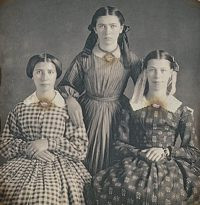 Two young pioneer girls wearing bonnets and dresses, accessorized with necklaces.
Two young pioneer girls wearing bonnets and dresses, accessorized with necklaces.
Accessories played a surprisingly significant role in the frontier woman’s wardrobe. Beyond the foundational pioneer dress, finishing touches were highly valued. Jewelry and accessories were so emphasized in historical accounts that they warrant a more detailed exploration in a future discussion.
Frontier women adorned themselves with:
- Aprons
- Boots
- Brooches
- Lockets
- Earrings
- Precious stones and metals
- Hair adornments
- Hats
- Collars and cuffs
- Gloves
- Undersleeves
- Parasols
- Fans
- Handbags
- Shawls
A Lasting Pioneer Legacy
My growing interest in my own pioneer ancestry has deepened my appreciation for this historical period. While “prairie style,” “pioneer,” and “western wear” clothing are readily available commercially today, uncovering detailed historical information about how women navigated their desires for propriety, beauty, and fashion amidst the rigorous demands of frontier life is a fascinating pursuit.
The pioneer dress and the broader wardrobe of frontier women represent a compelling blend of practicality and aspiration. It’s a topic I am eager to continue exploring, and I invite you to look for a follow-up article focusing specifically on accessories in frontier women’s fashion.
Embody the Pioneer Spirit: Create Your Own Pioneer Dress Look
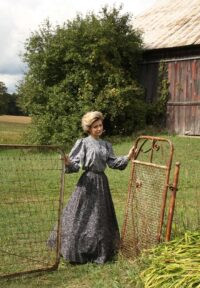 A woman wearing a pioneer style blue blouse and skirt standing in a grassy field.
A woman wearing a pioneer style blue blouse and skirt standing in a grassy field.
Pioneer Calico Blouse and Skirt
Browse our entire pioneer clothing collection
Pioneer Calico Blouse and Skirt
Harper Victorian Pioneer Dress
Pioneer Blouse, Apron and Skirt
